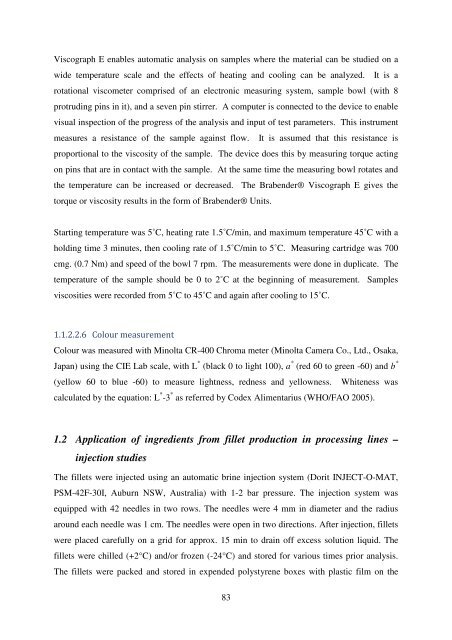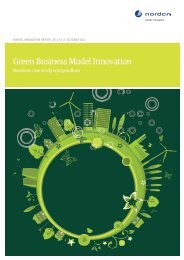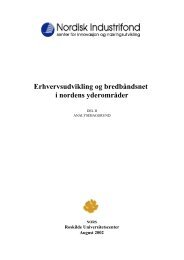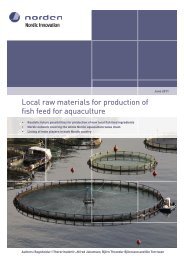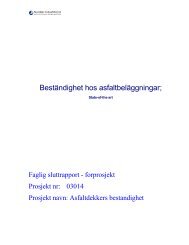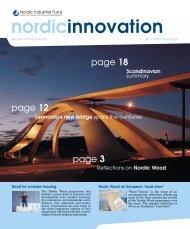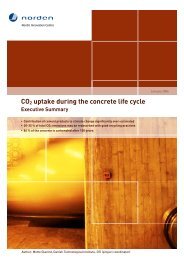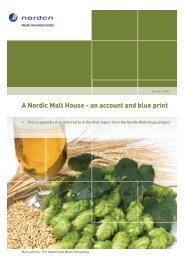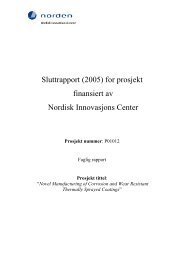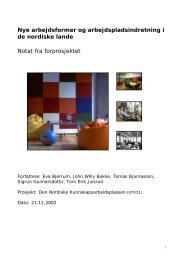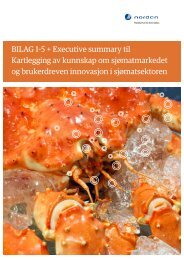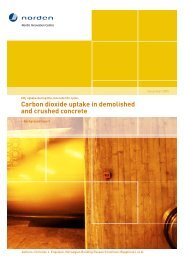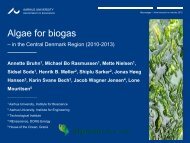Value added fish by-products - Nordic Innovation
Value added fish by-products - Nordic Innovation
Value added fish by-products - Nordic Innovation
You also want an ePaper? Increase the reach of your titles
YUMPU automatically turns print PDFs into web optimized ePapers that Google loves.
Viscograph E enables automatic analysis on samples where the material can be studied on a<br />
wide temperature scale and the effects of heating and cooling can be analyzed. It is a<br />
rotational viscometer comprised of an electronic measuring system, sample bowl (with 8<br />
protruding pins in it), and a seven pin stirrer. A computer is connected to the device to enable<br />
visual inspection of the progress of the analysis and input of test parameters. This instrument<br />
measures a resistance of the sample against flow. It is assumed that this resistance is<br />
proportional to the viscosity of the sample. The device does this <strong>by</strong> measuring torque acting<br />
on pins that are in contact with the sample. At the same time the measuring bowl rotates and<br />
the temperature can be increased or decreased. The Brabender® Viscograph E gives the<br />
torque or viscosity results in the form of Brabender® Units.<br />
Starting temperature was 5˚C, heating rate 1.5˚C/min, and maximum temperature 45˚C with a<br />
holding time 3 minutes, then cooling rate of 1.5˚C/min to 5˚C. Measuring cartridge was 700<br />
cmg. (0.7 Nm) and speed of the bowl 7 rpm. The measurements were done in duplicate. The<br />
temperature of the sample should be 0 to 2˚C at the beginning of measurement. Samples<br />
viscosities were recorded from 5˚C to 45˚C and again after cooling to 15˚C.<br />
1.1.2.2.6 Colour measurement<br />
Colour was measured with Minolta CR-400 Chroma meter (Minolta Camera Co., Ltd., Osaka,<br />
Japan) using the CIE Lab scale, with L * (black 0 to light 100), a * (red 60 to green -60) and b *<br />
(yellow 60 to blue -60) to measure lightness, redness and yellowness. Whiteness was<br />
calculated <strong>by</strong> the equation: L * -3 * as referred <strong>by</strong> Codex Alimentarius (WHO/FAO 2005).<br />
1.2 Application of ingredients from fillet production in processing lines –<br />
injection studies<br />
The fillets were injected using an automatic brine injection system (Dorit INJECT-O-MAT,<br />
PSM-42F-30I, Auburn NSW, Australia) with 1-2 bar pressure. The injection system was<br />
equipped with 42 needles in two rows. The needles were 4 mm in diameter and the radius<br />
around each needle was 1 cm. The needles were open in two directions. After injection, fillets<br />
were placed carefully on a grid for approx. 15 min to drain off excess solution liquid. The<br />
fillets were chilled (+2°C) and/or frozen (-24°C) and stored for various times prior analysis.<br />
The fillets were packed and stored in expended polystyrene boxes with plastic film on the<br />
83


